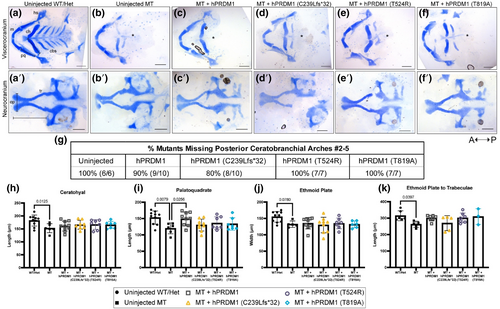Fig. 1 Transient overexpression of wildtype (WT) hPRDM1 in prdm1a−/− embryos rescues the palatoquadrate, while the split hand/foot malformation (SHFM) variants fail to rescue. prdm1a+/− heterozygous fish were intercrossed and injected with the hPRDM1 WT and SHFM variant mRNA at the single-cell stage. Injected larvae were collected at 4 dpf for Alcian blue staining. (a–f) Representative images of dissected craniofacial skeletons. The top row contains dissections of the viscerocranium, whereas the bottom row is the neurocranium. (A) Uninjected WT/heterozygous (n = 10). (b) Uninjected prdm1a−/− mutant (n = 6). prdm1a−/− mutants were injected with (c) WT hPRDM1 (n = 10), (d) hPRDM1(p.C239Lfs*32) (n = 10), (e) hPRDM1(p.T524R) (n = 7), or (f) hPRDM1(p.T819A) mRNA (n = 7). The asterisk (*) represents missing ceratobranchial arches. (g) Table showing the proportion of prdm1a−/− mutants that had missing posterior ceratobranchial arches #2–5. Measurements were taken to quantify the (h) length of the ceratohyal, (i) length of the palatoquadrate, (j) width of the ethmoid plate, and (k) length from the ethmoid plate to trabeculae. prdm1a−/− mutants have missing posterior ceratobranchial arches and a shorter ceratohyal, palatoquadrate, ethmoid plate, and neurocranium overall. Injection of WT hPRDM1 rescues the length of the palatoquadrate (p = .0256), while the other variants do not. Injection of WT hPRDM1, hPRDM1(p.T524R), and hPRDM1(p.T819A) modestly rescues the length of the neurocranium. cbs, ceratobranchial arches; ep, ethmoid plate; hs, hyosymplectic; m, Meckel's cartilage; pq, palatoquadrate; tr, trabeculae.
Image
Figure Caption
Acknowledgments
This image is the copyrighted work of the attributed author or publisher, and
ZFIN has permission only to display this image to its users.
Additional permissions should be obtained from the applicable author or publisher of the image.
Full text @ Birth Defects Res

